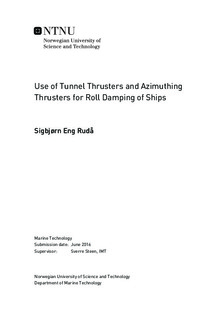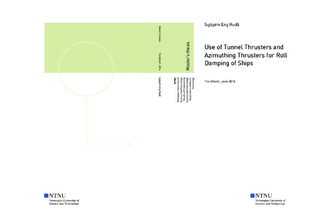| dc.description.abstract | This thesis presents a novel technique of active roll damping in marine vessels by the sole use of conventional thrusters. Many marine operations, such as crane operation and helicopter landings, should be carried out in small and steady roll motions. However, active roll damping devices such as fins and rudders lose their efficiency in low-speed conditions. This thesis provides a new methodology for roll reduction by adjusting the shaft speed and pitch of the propellers, by use of already installed thrusters.
In order to develop a simulation environment suitable for representing realistic roll damping scenarios and validate the damping contribution from the thrusters, systematic experimental trials were carried out in the large towing tank at MARINTEK. The simulation model is based on the MSS Toolbox, with additional modifications added to represent roll motions more realistically, i.e. 4-quadrant open water results and non-linear sway and roll damping.
The numerical simulations and experimental trials, presented in the thesis, are compared with ship operations that require low roll motions, and shows promising results with significant roll reduction. Seakeeping trials related to roll motions are carried out to quantify the damping contribution. Decay tests showed average damping ratio 250% higher using the proposed anti-roll system compared to the undamped case. Furthermore, regular waves showed 40% damping in the area around resonance. Additionally, statistical values from irregular wave trials showed damping in the regime 30-64%. Lastly, operability diagrams were created using numerical simulations and was compared with helicopter landing criteria. It was shown that helicopter landings could take place 34 % more often using the active roll damping system for oblique waves and 20% more often for beam waves.
Based on the results, it is concluded that the system works very well for moderate sea states, and that the damping contributions, that is to say in moderate sea state conditions, is comparable to that of currently available anti-roll systems | |

